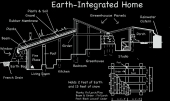posted 8 years ago
It is interesting to note that I came here due to rocket mass heaters as suggested by a friend, but deduced for my home it was not going to work. I am not saying they are bad or wrong, it just did not work well for our particular home. That being the case however, I did find a way to drastically reduce wood consumption in another manner: reduce the size of the firebox of a typical woodstove. For me it was through the use of a pot bellied stove.
Pot bellied stoves work well for us because they are smaller in footprint, that is being vertical more or less instead of blocky or horizontal. But they also take small wood. Last year when I was forced to use a regular stove most of the way through the winter, I found I was feeding it 16 inch long logs and not really needing all those btu's in my super-insulated home. With a pot bellied stove, since I typically cut up my wood into 5" long blocks, and split to less then 6 inches, I have better control over how much wood is burned, matching it to the degree days of the winter day.
As I type this it is 20 degrees outside so I have 6 blocks burning, a roaring fire for me, but on days I need to just keep the woodstove simmering, I might only have 1 block burning. In comparison, the least I could burn last year with traditional firewood lengths, was 3 blocks (the equivalent of (1) 16 inch block of wood) which was a waste of 2 of those 3 blocks because I really did not need it.
The trick then is to move the heat throughout the house so it is evenly heated. We do this through interior walls that are insulated. Granted part of that was for sound travel, but also for zone heating. By opening and closing doors, we can easily channel heat where we want it.
In the future we may use active solar gain (as opposed to passive solar gain), but we are not there yet.








